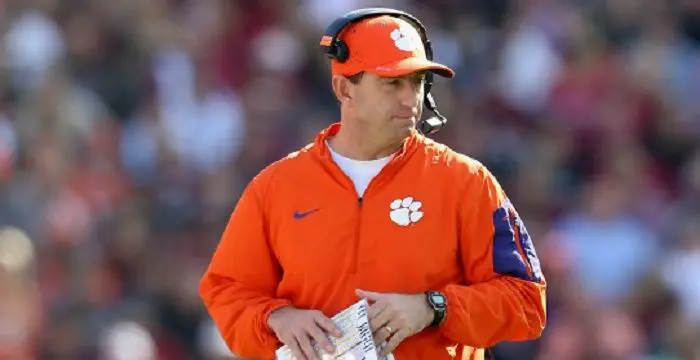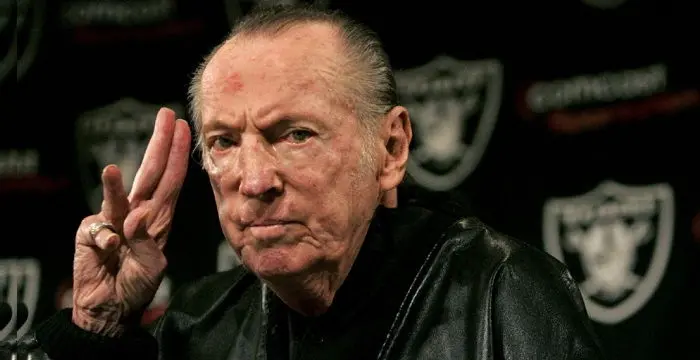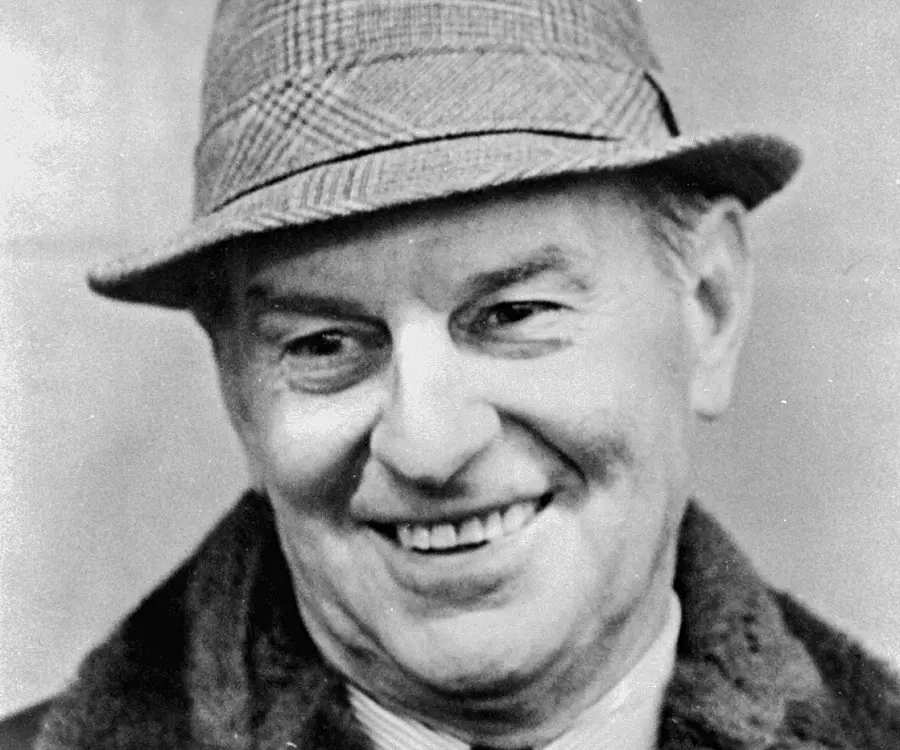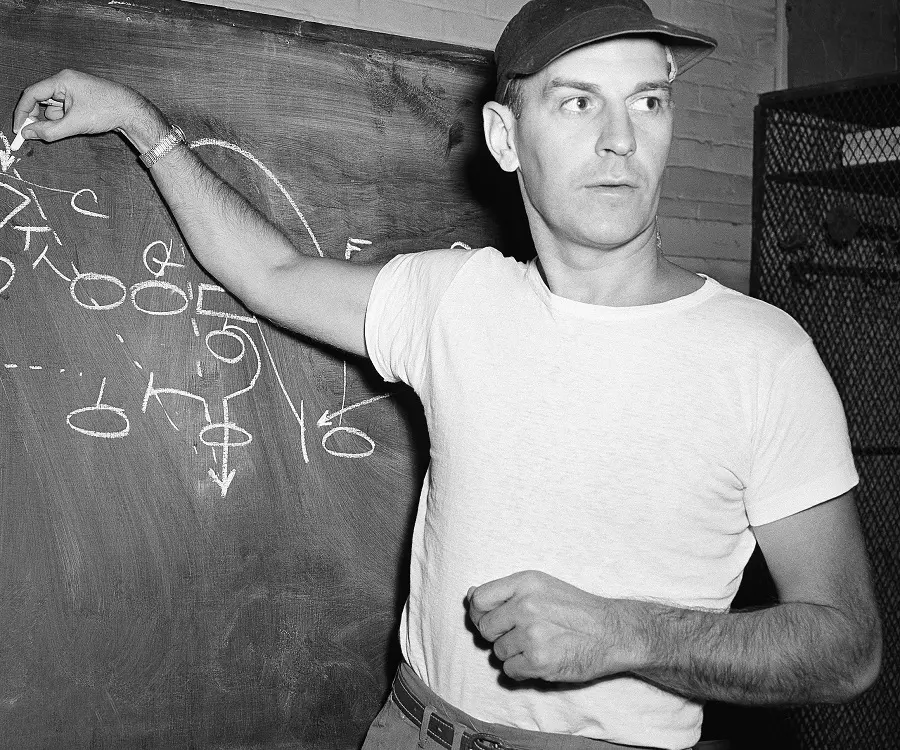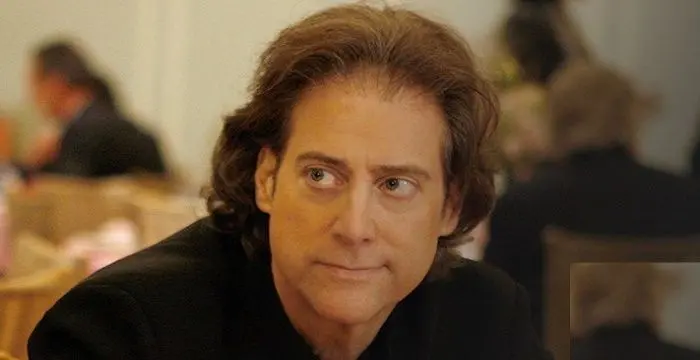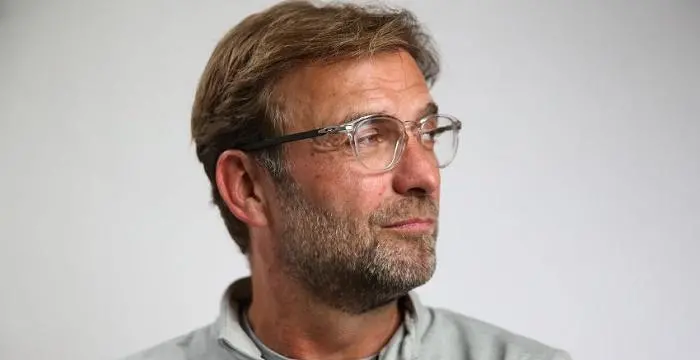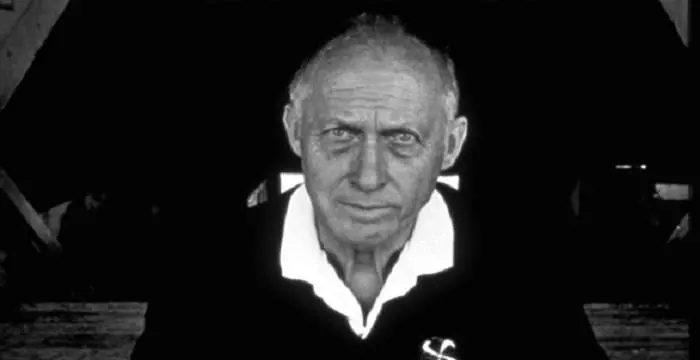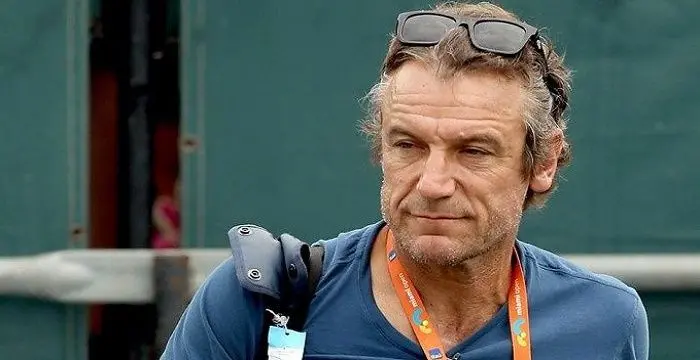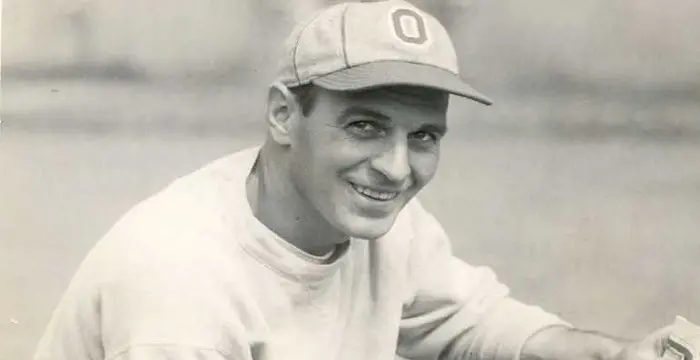
Paul Brown - Football Coach, Birthday and Childhood
Paul Brown's Personal Details
Paul Brown was a prominent American football coach
| Information | Detail |
|---|---|
| Birthday | September 7, 1908 |
| Died on | August 5, 1991 |
| Nationality | American |
| Famous | Miami University, Ohio State University, Sportspersons, Coaches, Football Coach |
| Spouses | Katie Kester (1929–1969; died), Mary Rightsell (1973–1991) |
| Known as | Paul Eugene Brown |
| Childrens | Mike Brown |
| Universities |
|
| Notable Alumnis |
|
| Birth Place | Norwalk |
| Gender | Male |
| Father | Lester |
| Sun Sign | Virgo |
| Born in | Norwalk |
| Famous as | American Football Coach |
| Died at Age | 82 |
// Famous Football Coach
David Moyes
David Moyes is a Scottish professional football coach and former player. Check out this biography to know about his birthday, childhood, family life, achievements and fun facts about him.
Dabo Swinney
Dabo Swinney is an American college football coach. Check out this biography to know about his birthday, childhood, family life, achievements and fun facts about him.
Al Davis
Al Davis was an American football coach and executive. This biography explores his childhood, early life, career, major works, awards, personal life, legacy, timeline and trivia.
Paul Brown's photo
Who is Paul Brown?
Paul Brown was a famous American football coach in the ‘All-America Football Conference’ and the ‘National Football League’. He became the head coach of the Cleveland Browns and he is also remembered for being one of the forces behind the establishment of the Cincinnati Bengals. Although disliked by some of his own players for his terse behavior and his dominating nature, he went on to become one of the most iconic football coaches in American history. His professional coaching career has crossed nearly 25 football seasons and under his leadership, his teams bagged seven league championships. He worked his way to success from a high school coach to a pro-football ‘Hall of Famer’. He is responsible for having advanced the sport into a more accurate discipline. In his long and illustrious career, he has had a profound influence on the game. From surveying rivals through ‘game films’ to forming the system of ‘draw play’ and systemizing the college draft, Brown had left a long-standing legacy in American football and has went on to inspire a number of modern-day coaches and players. He was inducted into the Pro Football Hall of Fame in 1967.
// Famous Miami University
P. J. O'Rourke
P. J. O’Rourke is an American journalist, political satirist and author. This biography provides detailed information on his childhood, life, career, achievements & timeline.
Ben Roethlisberger
Ben Roethlisberger is an American football quarterback, signed to Pittsburgh Steelers of the National Football League (NFL). Check out this biography to know about his childhood, family life, achievements and fun facts about his life.
Enrique Iglesias
Enrique Iglesias is a Spanish singer cum songwriter. This biography of Enrique Iglesias provides detailed information about his childhood, life, achievements, works & timeline
Childhood & Early Life
Paul Eugene Brown was born on 7 September 1908 in Norwalk, Ohio. When he was nine years old the family moved to Massillon, Ohio.
In 1922, he studied at Massillon Washington High School. Although he started playing football from a very young age, he didn’t qualify for the school team because he was ‘undersized’ for the sport. He graduated from the institute three years later.
He got into Ohio State University, where he hoped to make the Buckeyes Team. However, he did not get a chance to go for a tryout.
After his freshman year, he was transferred to Miami University, where he was drafted to the ‘All-Ohio small-college second team’ under Coach Chester Pittser, in 1928.
Although he had taken up the subject of pre-law in Miami and considered studying history on a Rhodes scholarship, he instead took up his first job as a coach at Severn School in Maryland, in 1930.
Career
After his second year at Severn School in Maryland, Massillon’s head coaching job became vacant and Brown took the position in 1931.
Brown was asked to work on the Massillon Tigers, discipline them and make them a meticulous team. It was here that he emphasized ‘quickness over strength’ with his players and no players were allowed to sit on the bench during a game; they were made to stand. It was this sort of a disciplinarian approach that improved the records of the Massillon Tigers.
In 1934, under his leadership, Massillon won all of its games until Canton defeated them 21-6 in the last game of the season.
Up to until 1940, he led the Massillon High School football team to an aggregate 59 wins, with only 1 forgettable loss. In 1940, he was made the head coach of the ‘Ohio State Buckeyes’.
In 1942, the ‘Ohio State Buckeyes’ clinched their first-ever national title, despite being threatened by the ensuing war situation on the home front. The next season was a mischance for both Brown and the Buckeyes.
In 1944, Brown was appointed as a lieutenant in the U.S. Navy. He served at the Great Lakes Naval Training Station in the outer parts of Chicago as head coach of its Bluejacket football team. During his tenure as lieutenant, he could have been called for active duty at any point of time, but the war began to end just as Brown settled.
In 1944, Arch Ward, an influential sports editor from the ‘Chicago Tribune’, projected a professional eight-team football league called the ‘All-America Football Conference’ (AAFC) after the war ended.
Brown was immediately offered the position of coaching the new team and he immediately accepted the job in 1945 at a monstrous $17,500 per year—higher than any other coach’s salary.
From 1946 to 1949, he prepared himself to put together a successful Cleveland Football Team called the ‘Browns’. It was at this time, he invented the ‘taxi squad’ and his team won the AAFC championship and every other game in the 1948 season. However, towards the end of this period, the AAFC league was struggling for endurance.
In 1950, the ‘Browns’, under his leadership, defeated the defending champion, the ‘Philadelphia Eagles’ during their first major game in the NFL. They had a successful 10-2 season, thrashing L.A. Rams to win the NFL Championship.
From 1951 to 1955, he led the Browns to the championship game for five consecutive years, winning it all in the 1954-1955 seasons. The next year, he encountered his first ‘defeated’ season as a coach.
In 1961, Art Modell, an advertising executive, bought the team for almost $4 million, buying out 15% stake in the team and leasing Brown a renewed 8-year contract. Modell soon began taking direct accountability over the team’s processes, which infuriated Brown.
The new ownership meant that there was a growing rift between the players and Brown and Brown and Modell himself. Brown was fired as coach on January 7, 1963. After a brief hiatus, he returned to coaching once again, this time with his new team; the Cincinnati Bengals, five years later.
In the 1968-1969 seasons, the Bengals progressed below par, but the team appeared to be on the upsurge as Brown built a strong bunch of players through the draft.
In his years as the coach of the Bengals, he took his team to the playoffs three times, including once in 1970.
After his team was jettisoned from the playoffs, Brown announced his official retirement from coaching in 1975. Following his retirement, he stayed on as the team president.
Awards & Achievements
In 1967, he was inducted into the ‘National Football Hall of Fame’.
In 2009, he was named the ‘12th greatest coach of all time’ by ‘Sporting News’, posthumously.
Personal Life & Legacy
He married Katie Kester in 1929 with whom he had three sons; Robin, Mike and Pete. He lost his wife and son, Robin, to cardiac arrest and cancer, respectively.
In 1973, he married former secretary Mary Rightsell.
Towards the end of his life, he rarely appeared in public and he passed away on 5 Aug 1991 at home after complications from pneumonia. He is interred at Rose Hill Cemetery.
After his death, his son, Mike succeeded him as the Bengals’ team president. In 2000, a new football facility called ‘Paul Brown Stadium’ was named after him.
His legacy although long-standing was not always a positive one. Many players remembered him for ill-treating them by not giving them pay-hikes or due to his arrogant behavior. Some even called him ‘cold and brutal’. Even after his death, Brown was a focal point of criticism.
Today, the concept of using a face-mask for football, the taxi-squad and the draw play are all used in modern-day American football, because Brown devised it during his lifetime.
Trivia
This American football coach who coached the Cleveland Browns and the Cincinnati Bengals prohibited his players from having social lives, drinking, and smoking. He even banned them from indulging in sexual intercourse on certain days of the week. Apart from all these rules, he made ‘coats and ties’ mandatory for the players, when they were out in the public.
// Famous Ohio State University
Richard Lewis
Richard Lewis is an American comedian. This biography provides detailed information on his childhood, life, career, work, achievements and timeline.
Jeffrey Dahmer
Jeffrey Lionel Dahmer was an American was a serial killer and a sex offender. This biography of Dahmer profiles his childhood, life, criminal and sexual offences and timeline.
James Thurber
James Thurber was an American author, journalist and cartoonist, famously known for his short stories and cartoons in ‘The New Yorker’ magazine. This biography offers detailed information on his childhood, life, achievements and timeline.
Paul Brown biography timelines
- // 7th Sep 1908Paul Eugene Brown was born on 7 September 1908 in Norwalk, Ohio. When he was nine years old the family moved to Massillon, Ohio.
- // 1922In 1922, he studied at Massillon Washington High School. Although he started playing football from a very young age, he didn’t qualify for the school team because he was ‘undersized’ for the sport. He graduated from the institute three years later.
- // 1928After his freshman year, he was transferred to Miami University, where he was drafted to the ‘All-Ohio small-college second team’ under Coach Chester Pittser, in 1928.
- // 1929He married Katie Kester in 1929 with whom he had three sons; Robin, Mike and Pete. He lost his wife and son, Robin, to cardiac arrest and cancer, respectively.
- // 1930Although he had taken up the subject of pre-law in Miami and considered studying history on a Rhodes scholarship, he instead took up his first job as a coach at Severn School in Maryland, in 1930.
- // 1931After his second year at Severn School in Maryland, Massillon’s head coaching job became vacant and Brown took the position in 1931.
- // 1940Up to until 1940, he led the Massillon High School football team to an aggregate 59 wins, with only 1 forgettable loss. In 1940, he was made the head coach of the ‘Ohio State Buckeyes’.
- // 1942In 1942, the ‘Ohio State Buckeyes’ clinched their first-ever national title, despite being threatened by the ensuing war situation on the home front. The next season was a mischance for both Brown and the Buckeyes.
- // 1944In 1944, Brown was appointed as a lieutenant in the U.S. Navy. He served at the Great Lakes Naval Training Station in the outer parts of Chicago as head coach of its Bluejacket football team. During his tenure as lieutenant, he could have been called for active duty at any point of time, but the war began to end just as Brown settled.
- // 1944In 1944, Arch Ward, an influential sports editor from the ‘Chicago Tribune’, projected a professional eight-team football league called the ‘All-America Football Conference’ (AAFC) after the war ended.
- // 1945Brown was immediately offered the position of coaching the new team and he immediately accepted the job in 1945 at a monstrous $17,500 per year—higher than any other coach’s salary.
- // 1946 To 1949From 1946 to 1949, he prepared himself to put together a successful Cleveland Football Team called the ‘Browns’. It was at this time, he invented the ‘taxi squad’ and his team won the AAFC championship and every other game in the 1948 season. However, towards the end of this period, the AAFC league was struggling for endurance.
- // 1950In 1950, the ‘Browns’, under his leadership, defeated the defending champion, the ‘Philadelphia Eagles’ during their first major game in the NFL. They had a successful 10-2 season, thrashing L.A. Rams to win the NFL Championship.
- // 1951 To 1955From 1951 to 1955, he led the Browns to the championship game for five consecutive years, winning it all in the 1954-1955 seasons. The next year, he encountered his first ‘defeated’ season as a coach.
- // 1961In 1961, Art Modell, an advertising executive, bought the team for almost $4 million, buying out 15% stake in the team and leasing Brown a renewed 8-year contract. Modell soon began taking direct accountability over the team’s processes, which infuriated Brown.
- // 1963The new ownership meant that there was a growing rift between the players and Brown and Brown and Modell himself. Brown was fired as coach on January 7, 1963. After a brief hiatus, he returned to coaching once again, this time with his new team; the Cincinnati Bengals, five years later.
- // 1967In 1967, he was inducted into the ‘National Football Hall of Fame’.
- // 1968 To 1969In the 1968-1969 seasons, the Bengals progressed below par, but the team appeared to be on the upsurge as Brown built a strong bunch of players through the draft.
- // 1970In his years as the coach of the Bengals, he took his team to the playoffs three times, including once in 1970.
- // 1973In 1973, he married former secretary Mary Rightsell.
- // 1975After his team was jettisoned from the playoffs, Brown announced his official retirement from coaching in 1975. Following his retirement, he stayed on as the team president.
- // 5th Aug 1991Towards the end of his life, he rarely appeared in public and he passed away on 5 Aug 1991 at home after complications from pneumonia. He is interred at Rose Hill Cemetery.
- // 2009In 2009, he was named the ‘12th greatest coach of all time’ by ‘Sporting News’, posthumously.
// Famous Coaches
Jürgen Klopp
Jürgen Klopp is a German football manager, and a former professional football player. Check out this biography to know more about his childhood, family, personal life, etc.
David Moyes
David Moyes is a Scottish professional football coach and former player. Check out this biography to know about his birthday, childhood, family life, achievements and fun facts about him.
Mike Ditka
Mike Ditka is a former American football NFL player coach and TV commentator. This biography profiles his childhood, life, career, achievements and timeline.
Bill Bowerman
Bill Bowerman was an American track and field coach, winner of the Oxford Cup and co-founder of the Nike, Inc. Check out this biography to get detailed information on his life.
Mats Wilander
Mats Wilander is a former World No. 1 professional tennis player from Sweden. This biography of Mats Wilander provides detailed information about his childhood, life, tennis career, achievements and timeline.
Pep Guardiola
Pep Guardiola is a former Spanish footballer. This biography provides detailed information about his childhood, family, personal life, career, etc.
Paul Brown's FAQ
What is Paul Brown birthday?
Paul Brown was born at 1908-09-07
When was Paul Brown died?
Paul Brown was died at 1991-08-05
Where was Paul Brown died?
Paul Brown was died in Cincinnati
Which age was Paul Brown died?
Paul Brown was died at age 82
Where is Paul Brown's birth place?
Paul Brown was born in Norwalk
What is Paul Brown nationalities?
Paul Brown's nationalities is American
Who is Paul Brown spouses?
Paul Brown's spouses is Katie Kester (1929–1969; died), Mary Rightsell (1973–1991)
Who is Paul Brown childrens?
Paul Brown's childrens is Mike Brown
What was Paul Brown universities?
Paul Brown studied at Miami University,Ohio State University, Miami UniversityMassillon Washington High School, Ohio State University
What was Paul Brown notable alumnis?
Paul Brown's notable alumnis is Miami University, Ohio State University
Who is Paul Brown's father?
Paul Brown's father is Lester
What is Paul Brown's sun sign?
Paul Brown is Virgo
How famous is Paul Brown?
Paul Brown is famouse as American Football Coach

